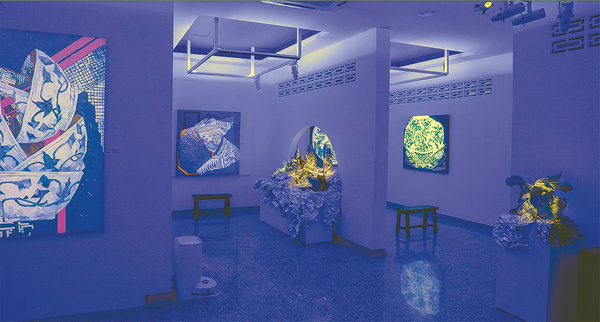
A glimpse of Malaysian artist Alice Chang's exhibition Me, Then Blue in Kuala Lumpur. The artworks draw inspiration from ancient China's blue-and-white porcelain. [Photo provided to China Daily]
From her studio tucked away in a quiet corner in Kuala Lumpur, Malaysian artist Alice Chang carefully blends a color palette of various shades of white and blue, meticulously using them to form intricate paintings of different motifs.
At first glance, one might find these pieces to be very similar to traditional Chinese porcelain. And they would be right.
Chang, inspired by porcelain artists of centuries past, held her fifth solo exhibition, Me, Then Blue, which reinterprets the traditional Chinese style for modern audiences. She is specifically into the blue-and-white porcelain wares from Jingdezhen — China's famed porcelain capital during the Ming Dynasty (1368-1644).
"Remember, many of these painters had no formal training, but were employed to hand-paint porcelain. They were not clouded by what others thought, and expressed themselves in the purest possible sense. They painted what they felt, what they saw in their everyday lives, in their own unique way," she says.
Ranging from conventional to impressionist pieces, Chang sculpts as well as paints, demonstrating the versatility of the painting style and the colors most often associated with it — minimalist, as well as complex works, covering the walls of her studio, which also doubles as an art gallery.
The discovery of the Wanli Shipwreck, a Portuguese trading vessel found off the coast of Terengganu that was carrying delicate blue-and-white porcelain from Jingdezhen, off Malaysia's east coast, struck a chord with Chang.
Valuable artifacts were found and salvaged along with large amounts of broken porcelain pieces regarded as having little value, which offered a record of the region's maritime history.
"What truly moved me were the broken pieces. They shared the same historic value as those that ended up in prestigious auction houses. I wanted to give them a new lease on life, to transform what was once considered worthless into something meaningful and beautiful," she explains.
"Even as fragments, they shared the story of the region's maritime history from the Portuguese sailors who were transporting them, the people and traders of pre-independence Malaysia, and the Chinese artisans who created them," she says.
In addition to paintings, Chang incorporated porcelain fragments into sculptures as part of her collection.
"There's a quiet poetry in working with what's broken. Through art, I hope to honor not just the objects, but the resilience and forgotten stories they represent," she says.
The exhibition features 20 paintings and 11 sculptures, each a meditation on memory and transformation, bridging art, archaeology, and a chapter of Malaysian history that has long been overlooked.
Chang also speaks about the value of art as a bridge between people of different countries and cultures, having met and collaborated with people all over the world as part of her 15-year journey as an artist.
"We have an affinity for one another. There are no boundaries in our shared passion for art, not just in admiring it, but also in creating it. When I travel to Indonesia, I can stay in a fellow artist's home. It's the same anywhere I go. Art brings people together," she says.
 Editor:Qiu Xiaochen
Editor:Qiu Xiaochen